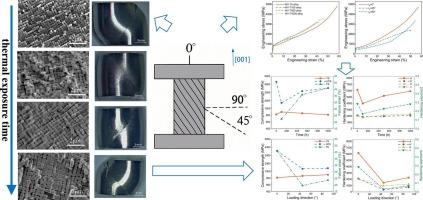Influence of γ′ phase on the microstructural evolution and compressive properties of Ni-based single crystal superalloys
IF 7.9
2区 材料科学
Q1 MATERIALS SCIENCE, MULTIDISCIPLINARY
引用次数: 0
Abstract
To facilitate the evaluation and prediction of hot-end component performance, scanning electron microscopy and quasi-static compression tests were carried out on Ni-based single crystal superalloys, and the influence of γ′ phase on microstructural evolution and compressive properties was systematically investigated. Results show that γ′ phases exhibit spherical, cubic, or lath-like morphologies, and their average size increases from ∼ 180 nm to ∼ 450 nm after thermal exposure; and superalloys with higher volume fraction of γ′ phase gradually precipitate topologically close-packed (TCP) phase. The compressive properties display pronounced anisotropy, governed by both microstructure and loading direction. For superalloys with lower volume fraction of γ′ phase, yield strength decreases from 670 MPa to 505 MPa and ultimate compressive strength from 4690 MPa to 4240 MPa as the γ′ phase coarsens. In contrast, for superalloys with higher volume fraction of γ′ phase, ultimate compressive strength initially decreases and then increases, accompanied by rise in failure strain from 22 % to 46 % after thermal exposure. With increasing loading angle, ultimate compressive strength initially decreases and then rises, whereas yield strength, failure strain and hardening modulus exhibit more complex trends. These variations are closely related to γ′ and TCP phase, and microstructure and loading direction collectively affect mechanical behavior.

γ′相对ni基单晶高温合金组织演变及压缩性能的影响
为了评价和预测热端构件性能,对ni基单晶高温合金进行了扫描电镜和准静态压缩实验,系统研究了γ′相对合金组织演变和压缩性能的影响。结果表明,γ′相呈球形、立方状或板条状形貌,热暴露后γ′相的平均尺寸从~ 180 nm增大到~ 450 nm;γ′相体积分数较高的高温合金逐渐析出拓扑紧堆积相(TCP)。压缩性能表现出明显的各向异性,受微观结构和加载方向的控制。对于γ′相体积分数较低的高温合金,随着γ′相的粗化,屈服强度从670 MPa降低到505 MPa,极限抗压强度从4690 MPa降低到4240 MPa。而γ′相体积分数较高的高温合金,其极限抗压强度先降低后升高,破坏应变从22%上升到46%。随着加载角度的增大,极限抗压强度先降低后升高,而屈服强度、破坏应变和硬化模量的变化趋势更为复杂。这些变化与γ′和TCP相密切相关,微观组织和加载方向共同影响力学行为。
本文章由计算机程序翻译,如有差异,请以英文原文为准。
求助全文
约1分钟内获得全文
求助全文
来源期刊

Materials & Design
Engineering-Mechanical Engineering
CiteScore
14.30
自引率
7.10%
发文量
1028
审稿时长
85 days
期刊介绍:
Materials and Design is a multi-disciplinary journal that publishes original research reports, review articles, and express communications. The journal focuses on studying the structure and properties of inorganic and organic materials, advancements in synthesis, processing, characterization, and testing, the design of materials and engineering systems, and their applications in technology. It aims to bring together various aspects of materials science, engineering, physics, and chemistry.
The journal explores themes ranging from materials to design and aims to reveal the connections between natural and artificial materials, as well as experiment and modeling. Manuscripts submitted to Materials and Design should contain elements of discovery and surprise, as they often contribute new insights into the architecture and function of matter.
 求助内容:
求助内容: 应助结果提醒方式:
应助结果提醒方式:


